
Landscaping a yard often involves the delivery of heavy materials. It makes sense to deliver materials as close to the site of use as possible. In some cases that may mean driving a truck over your lawn. Truckloads of rock or dirt weigh a significant amount and the weight of the truck passing over the softer surface of your lawn can create unsightly ruts. Rather than directing trucks to dump materials in your driveway, requiring you to make several trips with a wheelbarrow to move the materials to the desired location, you can take some simple precautions that will allow trucks to drive over your lawn without leaving ruts.
Step 1
Turn your sprinklers off several days before a scheduled delivery. If you know a truck is coming and that it will be driving over your lawn, you can mitigate damage by making sure your lawn is as dry as possible. Dry lawns are much more capable of supporting a truck's weight than are wet lawns.
Video of the Day
Step 2
Reschedule deliveries if it rains. It may delay your project, but delaying a delivery until conditions are dry can save your from having to repair damaged lawns and, even worse, damaged sprinklers.
Step 3
Know your lawn. The texture of a lawn varies. Some areas of your lawn may be very compact and hard. Others may be softer. Where possible, plan truck routes through your lawn that will avoid soft areas.
Step 4
Use mats specially designed to distribute the weight of the truck and to prevent lawn damage. (Landscapers and constructions workers use these types of mats and may be a good source to buy or rent them.) Lay the mats end to end to create a path for the truck across the lawn. Depending on the number of mats you have, you may have to stop and move mats from behind the truck to in front of the truck to extend the path. This can mean some stopping and starting, but it can save your lawn.
Video of the Day